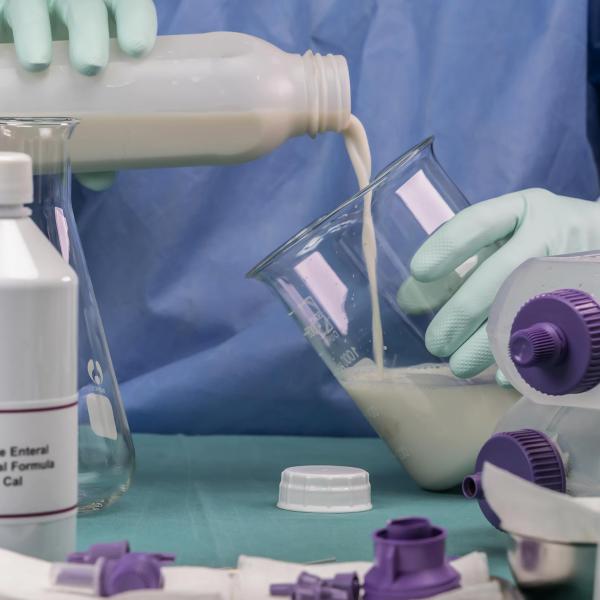Trypsin SE, known also as Pancreatin, is an enzyme complex extracted from, and comprising the core enzymes produced by the porcine pancreas. This endows Trypsin SE with broad enzymatic activities including; trypsin, chymotrypsin, lipase, elastase, amylase, and carboxypeptidase B (ECs 3.4.21.4, 3.4.21.1, 3.1 1.3, 3.4.21.36, 3.2.1.1, 3.4.17.2). This enzymatic profile allows faithful mimicking of the normal digestive functions of the pancreas, making Trypsin SE particularly well suited to applications that requiring digestion of fats, carbohydrates, and proteins.
Trypsin SE finds critical applications in the production of medical food, hydrolysed whey protein, and hypo-allergenic infant formula. In mammals, the constituent enzymes of pancreatin are synthesised as inactive precursors (known as proenzymes or zymogens), protecting and preventing the pancreas from digesting itself. The concerted activation of this enzyme cocktail commences in the duodenum, the beginning of the small intestine, where inactive trypsinogen converts into trypsin. This now active trypsin conveys its accompanying enzymes into their active forms, which begin their digestive work, degrading proteins into small peptide chains and amino acids to be absorbed into the blood. For its use in industrial applications, the enzymes comprising Trypsin SE are pre-activated by Neova Technologies Inc® during the production process.
Key Applications for Trypsin SE
Medical food, and enteral feeding
Patients with pancreatic deficiency require timely pancreatic enzymatic replacement therapy (PERT), as they are otherwise at serious risk of malnutrition, regardless of the nutritional value of their food intake. In cases of chronic pancreatitis, cystic fibrosis, diabetes, cancer of the pancreas, and after surgery on the gut or pancreas, pancreatin is routinely administered, supporting the digestive functions that may otherwise be insufficient for optimal digestion and absorption of their food. Indeed, for 87% of cystic fibrosis patients, enzyme replacement therapy is of critical necessity due to the insufficient functionality of their pancreas. Taken largely in an encapsulated form, PERT requires careful timing to ensure maximal efficiency. The pancreatic enzymes must be delivered to the small intestine, surviving the stomach intact, in coordination with the ingested meal or snack for it to function optimally. For patients with swallowing difficulties, pancreatin may also be delivered enterally, by a tube routed from the nose to the stomach.
Infant Formula, Digestibility and Hypoallergenic solutions
Mothers’ milk is well established as the ideal food for babies. Where breastfeeding is not possible, or otherwise inadequate, infant formula provides an excellent alternative. However, due to the cows’ milk source of the bulk of commercially available infant and follow-on formula, babies at high risk of milk allergy are susceptible to serious adverse reactions from these products. In these cases, the hypoallergenic formula offers a suitable, lower-risk alternative. These formulae are typically produced by pre-digestion of the cows’ milk, using enzymatic cocktails including Trypsin SE, pancreatin. Available as either partially hydrolysed, or extensively hydrolysed products (depending on the temperature, time, and enzyme/substrate conditions used), this approach breaks down the large proteins in the milk into smaller polypeptides which tend not to trigger adverse reactions. This pre-digestion is also utilised to aid the digestibility of non-hypoallergenic infant formula, making the polypeptides and amino acids more readily bio-available.
Whey Protein Hydrolysis
Protein supplementation is used extensively by athletes and those exercising intensively for its muscle repair, rebuilding and recovery properties. The bulk of proteins available on the market are sourced from cows’ milk, the protein content of which is 80% casein, and 20% whey. Indeed, whey protein is mostly produced from the dehydration of the liquid that remains after the cheese making process. Of the two, Casein is considered the slow-release protein, finding effective use overnight in providing prolonged release of proteins when there would otherwise be no protein intake. Whey protein, perhaps the better known, is characterised by a rapid, transient release of proteins that is highly effective immediately post intensive exercise.
Hydrolysation of whey improves the bioavailability of its amino acids, ‘pre-digesting the proteins into smaller peptides and amino acids that are rapidly delivered to the bloodstream to be utilised in muscle recovery after intensive exercise. Hydrolysed whey is also highly beneficial for those with lactose intolerances and milk allergies, as the proteins and lactose that may otherwise trigger a reaction are degraded into forms that do not. Trypsin SE, pancreatin is one of the enzyme preparations most commonly used in the hydrolysation of whey, due to its effectiveness, and broad digestive enzyme profile




